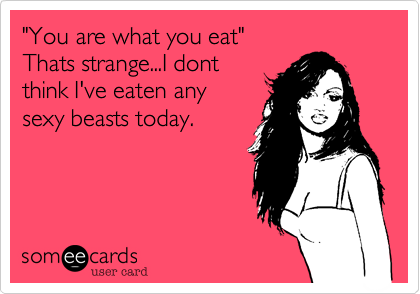This past summer, I decided to challenge myself by being a
vegetarian. Honestly, I’m a steak and potato girl. Beef burritos, sesame
chicken, pork chops and applesauce, sign me uuup. Growing up, a meal wasn’t a
meal without meat. So yeah, this would be a challenge.
Before getting into the logistics, let me give you a little
background about why I decided to do it, and why I’m planning on doing it
again.
It has been proven that vegetarians have healthier diets,
when they do it correctly. Meat can vary in protein and fat content. Protein
can be found in eggs and various plant sources and with a background in
culinary I knew I’d have no trouble making up for the loss. Cholesterol,
however, is found only in animal sources and can lead to multiple health issues
if not properly monitored. (See “You Are What You Eat”)
My biggest challenge was probably eating at other people’s
houses. I felt guilty turning down food, and felt like a burden when they would
make me something special. I often turned down that offer and found something
to eat that was already made. That generally meant a lot of potatoes and pasta,
all of the carbs.
In order to keep a balanced diet, I had to make sure that I
wasn’t replacing meat with more carbohydrates because that’s automatically the
easiest thing to do. More pasta, more rice, more bread, why would I complain?
Here’s a quick carb lesson- carbohydrates will break down into sugar. Sugar
makes energy. Excess energy is turned into fat store. So, too many carbs will
result in excess energy, which will be stored if not used and turn into fat.
See, that was quick.
The type of vegetarian diet I chose is called Lacto-Ovo,
this means that I was able to eat milk products and eggs. Doing so, I kept
dairy (calcium), and some animal proteins in my diet. To replace meat, my
protein came from a variety of sources such as beans and legumes, nuts and
seeds, and tofu. The tricky part about protein is that it comes in many
different pieces called amino acids. Amino acids literally build the structure
of your body and some we even produce ourselves. Other amino acids that our
body needs have to come from the food we eat. Animal-based proteins are the
only source that will come with a complete set of all the body’s essential
amino acids that we don’t make ourselves. In order to get a complete set of
essential amino acids from plant-based sources, it is important to combine
different foods throughout your day. For example, a handful of almonds in Greek
yogurt, multigrain bread with peanut butter, hummus with sesame seed crackers
and brown rice and beans.
By the end of the summer, I honestly felt really great. I
felt like my meals were lighter, I wasn’t as weighed down after a meal, and the
best part of all, I lost 5 pounds! I didn’t feel so weighed down after a meal,
as I would if I had just had a cheeseburger. It also made me more conscious of
what I was eating in general. If I wasn’t going to eat meat to be healthier,
then why would I replace all of that fat with French fries and pizza? Not that I
didn’t eat those things because I definitely couldn’t give that up, but I wouldn’t
choose them as options all the time.
Overall, I would recommend vegetarian diets to people,
especially those with heart and cholesterol issues. For my carnivores out
there, this would be a big commitment, so start smaller. Meatless Monday is my
favorite thing in the world, well at least top 5. I think it’s a great start to
lowering cholesterol and risks for heart disease.
Keep checking back for plenty of vegetarian recipes throughout my next summer as a vegetable. I'll have some meat ones on there too ;)
Don't forget to follow me!
Twitter: @Flat_Belly_Blog
Instagram: FlatBellyBlog








